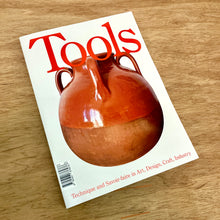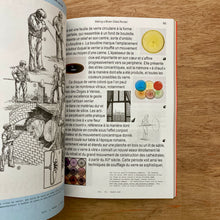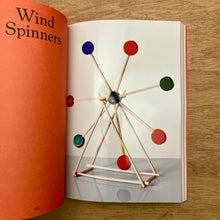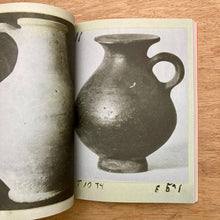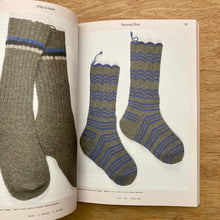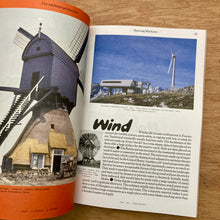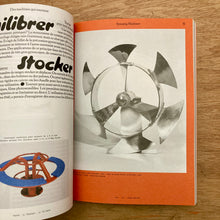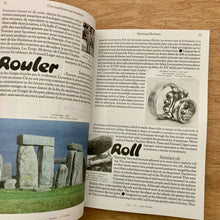Tools Issue 5
Regular price
£22.00
Sale
It's the new Tools, here right now, and always a sell out. This is our favourite French/English magazine about STUFF. Making, crafting, designing, all the bits, all the people doing the bits. We love it so much. For fans of Macguffin, Too Much, Chalk and Go Out. We're also getting a small quantity of issue 4 back in stock too, here's a link.
"The fifth issue of the annual magazine that promotes know-how and technique in design, craft or industry looks at the act of spinning.
To Spin. The world is spinning, and so is everything on it: you and me, the trees, the oceans, and the mountains. We may have deluded ourselves into thinking everything is stationary, but the reality is that we're perpetually in motion. The planet is spinning around its axis and orbiting around the sun, and in a way, at this very moment, we are all products of rotation: life on Earth is only possible because of the cycles of days, seasons, and years.
of rotation: life on Earth is only possible because of the cycles of days, seasons, and years. As Simon Bauchet writes in his article "Spinning Machines", humans have always used rotational movement to run machines and produce the material world around us. To Spin is more than just a word: it's a dynamic, a force, a necessity, even a philosophy. Craftspeople know this well. Their workshops are filled with spinning objects: the potter's wheel, the wood turner's lathe, the spool of a spinner who pulls wool to make yarn. Glass, too, can be spun by glassblowers into rondels, discs that capture the light and are the ancestors of our modern windowpanes. Antique glass is evidence of this know-how: irregular and vibrant, its appearance reflects its own artisanal production. It's not an easy material to work with: you have to understand its rhythm, guide its movement, and follow the direction of the shape it wants to take, rather than fighting it. We wonder: why does rotation often make it more docile? Why does spinning it make it lighter? Everything hinges on mastering the spin, on the balance between speed and precision. Every movement, every rotation, matters. Too fast, and it all collapses; too slow, and nothing takes shape.
We also look further afield. We brush up on basic physics: centrifugal, gravitational, and gyroscopic forces, like those that allow a frisbee to glide through the air. Wherever energy is found in nature's chaotic movements, people have usually managed to capture it with technologies that turn. Windmills, those testaments to centuries of ingenuity, their sails moving in the slightest breeze, have today been replaced by hydroelectric turbines, often gigantic, that transform the energy in water into electricity. Wind spinners, kinetic sculptures that make the wind visible through continuous rotation, reflect our need to play with movement—not just to use it, but also to admire it for what it is: a phenomenon both powerful and hypnotic.
And then we look up, and see more circles. The seasonal cycle repeats tirelessly. The sun rises, sets, and returns. The moon grows, disappears, and is reborn. The shape and cyclical nature of these natural rhythms gave rise to another human invention, which hasn't stopped going around since: time! Ever since we began measuring it with clocks, time has achieved the feat of spinning while always moving forward. You might think that turning means repeating, being forever doomed to go back to the same starting point. But that's not true. Rotation is progress. Each spin takes us somewhere new. Each cycle, even if it seems identical, is in fact a variation, a new step. It's a loop that never closes—in any case, that's how we see it in this new issue of Tools.
There's something dizzying about this idea. If everything is turning, nothing ever stops. Time marches on, inexorable. On clock faces, hands draw circles relentlessly. It's a reminder that everything will pass, that everything will change. That we, too, are caught up in this grand movement: our very existence is a revolution, a cycle with a beginning and an end. It's like a record where the needle never stops following the grooves, and plays the same melody over and over again, but never exactly the same song.
The human body can also spin. Dancers who spin— defying gravity, playing with balance, creating movement with their own inertia—know this dizziness well. Take the skater who accelerates their rotation by bringing their arms closer to their body, or the pole dancer who uses the distribution of their own weight to play around with the pole. Playing with this dizziness and turning it into a source of creation and expression is one of the many beautiful things humans know how to do.
Even our thoughts follow rotational logic. In French, an idea that comes to you, leaves, and returns in another form is said to tourner en boucle—literally, go around in circles; figuratively, play on repeat. That's not necessarily a bad thing: coming back to the same intuitions and images over and over can give them the time they need to find their ideal shape, like a ball of clay on the potter's wheel.
like a ball of clay on the potter's wheel. This issue of Tools is the most dynamic to date. It moves, whirls, and sways; it almost makes our heads spin. It's inspired by nature but also by human hands, which have always guided and tamed a world in motion. This issue is even a little mystical; the universe reminds us that everything, at its core, is about rotation.
of rotation: life on Earth is only possible because of the cycles of days, seasons, and years. As Simon Bauchet writes in his article "Spinning Machines", humans have always used rotational movement to run machines and produce the material world around us. To Spin is more than just a word: it's a dynamic, a force, a necessity, even a philosophy. Craftspeople know this well. Their workshops are filled with spinning objects: the potter's wheel, the wood turner's lathe, the spool of a spinner who pulls wool to make yarn. Glass, too, can be spun by glassblowers into rondels, discs that capture the light and are the ancestors of our modern windowpanes. Antique glass is evidence of this know-how: irregular and vibrant, its appearance reflects its own artisanal production. It's not an easy material to work with: you have to understand its rhythm, guide its movement, and follow the direction of the shape it wants to take, rather than fighting it. We wonder: why does rotation often make it more docile? Why does spinning it make it lighter? Everything hinges on mastering the spin, on the balance between speed and precision. Every movement, every rotation, matters. Too fast, and it all collapses; too slow, and nothing takes shape.
We also look further afield. We brush up on basic physics: centrifugal, gravitational, and gyroscopic forces, like those that allow a frisbee to glide through the air. Wherever energy is found in nature's chaotic movements, people have usually managed to capture it with technologies that turn. Windmills, those testaments to centuries of ingenuity, their sails moving in the slightest breeze, have today been replaced by hydroelectric turbines, often gigantic, that transform the energy in water into electricity. Wind spinners, kinetic sculptures that make the wind visible through continuous rotation, reflect our need to play with movement—not just to use it, but also to admire it for what it is: a phenomenon both powerful and hypnotic.
And then we look up, and see more circles. The seasonal cycle repeats tirelessly. The sun rises, sets, and returns. The moon grows, disappears, and is reborn. The shape and cyclical nature of these natural rhythms gave rise to another human invention, which hasn't stopped going around since: time! Ever since we began measuring it with clocks, time has achieved the feat of spinning while always moving forward. You might think that turning means repeating, being forever doomed to go back to the same starting point. But that's not true. Rotation is progress. Each spin takes us somewhere new. Each cycle, even if it seems identical, is in fact a variation, a new step. It's a loop that never closes—in any case, that's how we see it in this new issue of Tools.
There's something dizzying about this idea. If everything is turning, nothing ever stops. Time marches on, inexorable. On clock faces, hands draw circles relentlessly. It's a reminder that everything will pass, that everything will change. That we, too, are caught up in this grand movement: our very existence is a revolution, a cycle with a beginning and an end. It's like a record where the needle never stops following the grooves, and plays the same melody over and over again, but never exactly the same song.
The human body can also spin. Dancers who spin— defying gravity, playing with balance, creating movement with their own inertia—know this dizziness well. Take the skater who accelerates their rotation by bringing their arms closer to their body, or the pole dancer who uses the distribution of their own weight to play around with the pole. Playing with this dizziness and turning it into a source of creation and expression is one of the many beautiful things humans know how to do.
Even our thoughts follow rotational logic. In French, an idea that comes to you, leaves, and returns in another form is said to tourner en boucle—literally, go around in circles; figuratively, play on repeat. That's not necessarily a bad thing: coming back to the same intuitions and images over and over can give them the time they need to find their ideal shape, like a ball of clay on the potter's wheel.
like a ball of clay on the potter's wheel. This issue of Tools is the most dynamic to date. It moves, whirls, and sways; it almost makes our heads spin. It's inspired by nature but also by human hands, which have always guided and tamed a world in motion. This issue is even a little mystical; the universe reminds us that everything, at its core, is about rotation.
Hang on tight. Let's go for a spin!"











